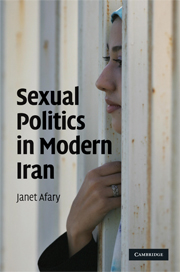Book contents
- Frontmatter
- Contents
- List of illustrations
- Acknowledgments
- Map of Iran
- Introduction
- Part 1 Premodern practices
- 1 Formal marriage
- 2 Slave concubinage, temporary marriage, and harem wives
- 3 Class, status-defined homosexuality, and rituals of courtship
- Part 2 Toward a Westernized modernity
- Part 3 Forging an Islamist modernity and beyond
- Conclusion: Toward a new Muslim-Iranian sexuality for the twenty-first century
- Glossary
- Bibliography
- Index
3 - Class, status-defined homosexuality, and rituals of courtship
Published online by Cambridge University Press: 05 June 2014
- Frontmatter
- Contents
- List of illustrations
- Acknowledgments
- Map of Iran
- Introduction
- Part 1 Premodern practices
- 1 Formal marriage
- 2 Slave concubinage, temporary marriage, and harem wives
- 3 Class, status-defined homosexuality, and rituals of courtship
- Part 2 Toward a Westernized modernity
- Part 3 Forging an Islamist modernity and beyond
- Conclusion: Toward a new Muslim-Iranian sexuality for the twenty-first century
- Glossary
- Bibliography
- Index
Summary
Although Islamic law prohibits homosexuality, same-sex relationships for men and women in the Mediterranean-Muslim world were implicitly recognized cultural practices, so long as they remained discreet and respected certain conventions. As in many other premodern cultures, Iranians expected male homosexual relations to be asymmetrical, involving people of different ages, classes, or social standings, although other types of same-sex relations were also practiced. Often one partner assumed the “masculine” gender conventions and another the “feminine.” As recent scholarship has demonstrated, in most premodern Western societies individuals were not identified by the sex of their object of desire. A man who had sex with other men was not identified as “homosexual,” nor was a man who had sex with women called a “heterosexual.” Rather, people were identified by their supposed positionality in the sexual relationship. The term status-defined homosexuality has been coined to distinguish these earlier norms concerning male homosexuality from those now predominant in the United States and the Western world. Male status-defined homosexuality involved sex between a man and an adolescent boy (amrad) – in which the man was assumed to be the active partner, and the amrad a passive recipient of his affection. The relationship was defined by rules of courtship and mentorship between the man and the youth and was expected to end when the youth reached adulthood.
- Type
- Chapter
- Information
- Sexual Politics in Modern Iran , pp. 79 - 108Publisher: Cambridge University PressPrint publication year: 2009



